Try These Beautiful Plants with Colored Leaves

Do you want an extra bit of decor in your house or yard? Then keep reading because we’re going to talk about plants with colored leaves. You’ll love them!
Plants with colored leaves in tones of purple, red, cream, orange, or yellow fit beautifully in your yard or inside your home. They give life to any environment.
In combination with other species with green leaves, they can create a beautiful contrast. Also, they add a touch of pizazz to the environment. But, we recommend that you are selective in how they look since they last much longer than flowering plants.
How do plants with colored leaves get their color?

Why do these plants have such colored leaves? The answer is very simple. It’s because the pigments in the leaves absorb the light during photosynthesis.
Besides the chlorophyll, some species have other pigments such as carotene, producing reddish colors in the leaves. However, these are of tropical origin and live in microhabitats where the light is muted.
Plants with colorful leaves have often been hybrid by humans. Consequently, in natural conditions, they would be difficult to produce.
Four varieties of plants with colored leaves
Let’s talk about four varieties of plants with colored leaves that you’ll want to have in your house or yard. We’re sure that in the end, you won’t know which ones to choose. For that reason, we recommend that you choose all four of them!
-
Croton (Codiaeum)
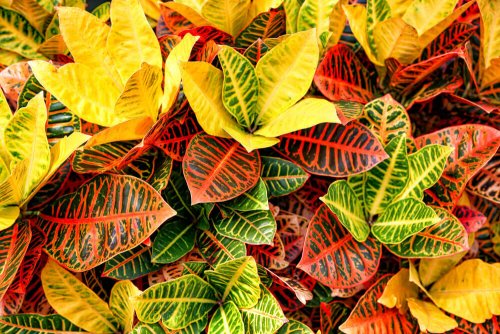
With leaves that are large and thick, opaque, and flexible, the croton is a small bush. Its leaves tend to have different colors (yellow with orange and green, red and dark gray, purple and green). For added interest, the leaves have different shapes. They may be pointed, dome-shaped, or striped. One plant can even have different leaves.
It’s good to be aware that you’ll need warm earth, light, and a humid environment. Under 53 F degrees, the croton will lose it’s lower leaves. At the same time, it shouldn’t be exposed to direct sunlight in the heat of the summer.
Be aware that the resin of the plant is released when the leaves are torn and are toxic. Therefore, you need to be vigilant if you have small children that could touch them.
2. Begonia (Begonia rex)
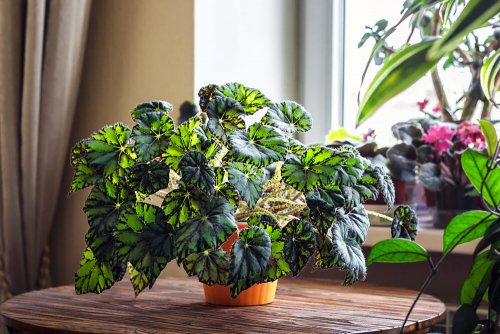
It’s interesting to know that many hybrids have been created from the begonia. So many that you can hardly find any in their purest form. But these hybrids are more adapted to growing indoors.
The begonia was a forest plant of India with wide rootstocks and twisted oval leaves. They had a dark green metallic color and a wide stripe in the center bordered by a wine color.
One of the most outstanding varieties is Merry Christmas, with reddish-brown leaves and green, silver, and pink stripes. The other is King Edward IV which has red leaves and pink spots.
3. Dracaena (Dracaena)
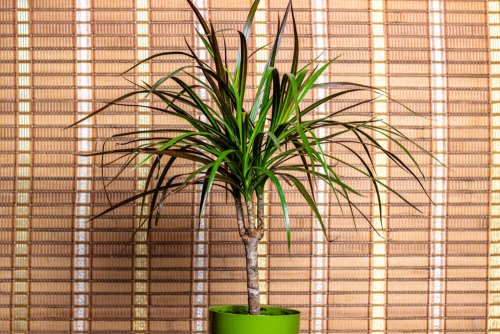
Among the commonly named dracaenas, the most common species for indoors are the Dracaena marginata, D. fragans, D. demenensis, and D. song India. Don’t worry, you’ll end up knowing their names.
They tend to develop a trunk that produces large striped leaves that are thick and usually variegated. They are 12 to 16 inches long and 10 inches wide in some species.
It’s a good idea to take them outside for a short time in the summer. But you’ll have to put them in the shade since they don’t like direct sunlight.
4. Coleus (Coleus or Solenostemon)
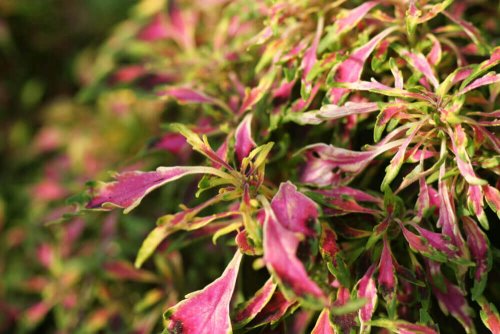
Coleus is a beautiful lively herbaceous plant with lots of branches. Also, it has soft stems that are full of sap. Coleus has serrated leaves in oval shapes with bright colors such as yellow, red, orange, green, white, and purple. As a result, these combine to create harmonious shapes.
To conserve its colors, this plant needs intense light. Even though it doesn’t require a lot of water, it’ll need more when it’s hot to keep it from wilting.
One advantage that coleus has is the ability to adapt well to cultivating from cuttings and it’s easy to start from seeds. So it’s only a question of placing it in a location where it’s able to grow without problems.
Advice for growing plants with colored leaves
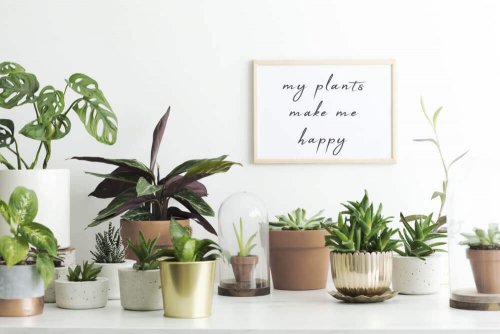
Let’s look at some tips for having plants with beautiful colored leaves. However, you don’t have to strictly follow these, but it’s a good idea to be aware of this advice. So let’s begin!
How about pinching back the tips of the young shoots of the plant? Try doing this in the spring to make the plant more full. f you do this regularly, you’ll end up with a plant that is more compact and round.
And don’t forget to change the pot for a larger one every year or two. Because a large pot will stimulate the development of the roots and better growth, which will make your plant more beautiful.
Are you excited about having plants with colored leaves? We’re sure that your answer will be “yes”!
https://midecoracion.com/jardineria/plantas-hojas-coloreadas/
Do you want an extra bit of decor in your house or yard? Then keep reading because we’re going to talk about plants with colored leaves. You’ll love them!
Plants with colored leaves in tones of purple, red, cream, orange, or yellow fit beautifully in your yard or inside your home. They give life to any environment.
In combination with other species with green leaves, they can create a beautiful contrast. Also, they add a touch of pizazz to the environment. But, we recommend that you are selective in how they look since they last much longer than flowering plants.
How do plants with colored leaves get their color?

Why do these plants have such colored leaves? The answer is very simple. It’s because the pigments in the leaves absorb the light during photosynthesis.
Besides the chlorophyll, some species have other pigments such as carotene, producing reddish colors in the leaves. However, these are of tropical origin and live in microhabitats where the light is muted.
Plants with colorful leaves have often been hybrid by humans. Consequently, in natural conditions, they would be difficult to produce.
Four varieties of plants with colored leaves
Let’s talk about four varieties of plants with colored leaves that you’ll want to have in your house or yard. We’re sure that in the end, you won’t know which ones to choose. For that reason, we recommend that you choose all four of them!
-
Croton (Codiaeum)

With leaves that are large and thick, opaque, and flexible, the croton is a small bush. Its leaves tend to have different colors (yellow with orange and green, red and dark gray, purple and green). For added interest, the leaves have different shapes. They may be pointed, dome-shaped, or striped. One plant can even have different leaves.
It’s good to be aware that you’ll need warm earth, light, and a humid environment. Under 53 F degrees, the croton will lose it’s lower leaves. At the same time, it shouldn’t be exposed to direct sunlight in the heat of the summer.
Be aware that the resin of the plant is released when the leaves are torn and are toxic. Therefore, you need to be vigilant if you have small children that could touch them.
2. Begonia (Begonia rex)

It’s interesting to know that many hybrids have been created from the begonia. So many that you can hardly find any in their purest form. But these hybrids are more adapted to growing indoors.
The begonia was a forest plant of India with wide rootstocks and twisted oval leaves. They had a dark green metallic color and a wide stripe in the center bordered by a wine color.
One of the most outstanding varieties is Merry Christmas, with reddish-brown leaves and green, silver, and pink stripes. The other is King Edward IV which has red leaves and pink spots.
3. Dracaena (Dracaena)

Among the commonly named dracaenas, the most common species for indoors are the Dracaena marginata, D. fragans, D. demenensis, and D. song India. Don’t worry, you’ll end up knowing their names.
They tend to develop a trunk that produces large striped leaves that are thick and usually variegated. They are 12 to 16 inches long and 10 inches wide in some species.
It’s a good idea to take them outside for a short time in the summer. But you’ll have to put them in the shade since they don’t like direct sunlight.
4. Coleus (Coleus or Solenostemon)

Coleus is a beautiful lively herbaceous plant with lots of branches. Also, it has soft stems that are full of sap. Coleus has serrated leaves in oval shapes with bright colors such as yellow, red, orange, green, white, and purple. As a result, these combine to create harmonious shapes.
To conserve its colors, this plant needs intense light. Even though it doesn’t require a lot of water, it’ll need more when it’s hot to keep it from wilting.
One advantage that coleus has is the ability to adapt well to cultivating from cuttings and it’s easy to start from seeds. So it’s only a question of placing it in a location where it’s able to grow without problems.
Advice for growing plants with colored leaves

Let’s look at some tips for having plants with beautiful colored leaves. However, you don’t have to strictly follow these, but it’s a good idea to be aware of this advice. So let’s begin!
How about pinching back the tips of the young shoots of the plant? Try doing this in the spring to make the plant more full. f you do this regularly, you’ll end up with a plant that is more compact and round.
And don’t forget to change the pot for a larger one every year or two. Because a large pot will stimulate the development of the roots and better growth, which will make your plant more beautiful.
Are you excited about having plants with colored leaves? We’re sure that your answer will be “yes”!
https://midecoracion.com/jardineria/plantas-hojas-coloreadas/







